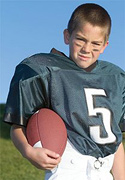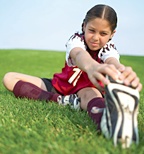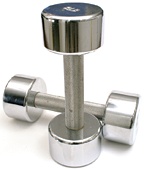Keeping Them Safe
By Kathryn Feather
Many parents proudly wear the mantle of "Soccer Mom" or "Football Dad." These tireless supporters spend their weekends chauffeuring kids back and forth between any number of team and individual sporting events. They invest countless hours in travel time and spend large portions of their paychecks on the necessities of maintaining this life. What many parents, as well as coaches, don't always think about is the time and money spent dealing with sports-related injuries. Many kids today begin competing at an early age and some even have the ability to enter elite competition when their peers are just beginning to figure out how to survive junior high. For parents, this presents challenges on many levels, including physical, mental as well as emotional issues their kids might encounter as they develop their skills and dream of becoming professional athletes. No matter what their skill level, kids need parents who will monitor their workouts, help prepare meals to give them the nutrition they need to stay competitive and healthy, and be there for them emotionally when a game or meet doesn't go as planned. Getting your kids involved in sports is a great way to teach them discipline, sportsmanship, honesty, perseverance and how to stay calm and collected in high-stress situations. Most kids won't win Olympic gold or sign pro contracts worth millions, but the following tips can help them become healthy competitors and keep injuries at bay. Feeding Growing, Competitive Bodies
 Children and teenagers have unique nutritional needs as they continue to grow and develop. Those who are competitive athletes have to pay even closer attention to their diets in order to avoid injury and stay healthy and active. Child and teen athletes generally need more calories to not only fuel their athletic activities, but also fuel their growth. Depending on the level of activity, teenage athletes need between 2,000 and 5,000 calories per day to meet their energy and nutritional needs.
Children and teenagers have unique nutritional needs as they continue to grow and develop. Those who are competitive athletes have to pay even closer attention to their diets in order to avoid injury and stay healthy and active. Child and teen athletes generally need more calories to not only fuel their athletic activities, but also fuel their growth. Depending on the level of activity, teenage athletes need between 2,000 and 5,000 calories per day to meet their energy and nutritional needs. If young athletes don't ingest enough calories, their bodies might not achieve peak performance. Extreme calorie restriction can lead to growth problems and other potentially serious health issues for both boys and girls. Dieting is generally not recommended for young athletes. Teenagers, especially, might have body image issues so working with a doctor or a psychologist is important to help them maintain a realistic and healthy outlook. Eating disorders are a common problem for young women. Female athletes can develop some serious health issues if they combine strenuous athletic activity with improper nutrition resulting from an eating disorder. They can be at risk for a condition known as female athlete triad. This is a combination of three separate conditions: eating disorders (anything from avoiding certain foods to anorexia nervosa or bulimia nervosa), amenorrhea (a decrease in estrogen which results in an irregular menstrual cycle) and osteoporosis (a weakening of the bones due to the loss of bone density and improper bone formation). A young female athlete can suffer from one or all of these conditions. Although most commonly thought of in female athletes, male athletes can suffer from eating disorders as well. Sports emphasizing weight include wrestling, swimming, track or gymnastics and those participating in these activities might feel pressure from coaches, parents or teammates to lose weight. It's important to work with a health professional to develop a plan that allows for weight loss when necessary, but also puts young bodies on a path to better health as well as better performance. Experts advise eating a variety of foods including lean proteins, fats and carbohydrates to maintain energy levels on a consistent basis. It's also important for young athletes to get the right combinations of vitamins and minerals. Strong bones will help reduce the potential for stress fractures so calcium is an essential component, in addition to iron which carries oxygen to hardworking and developing muscles. Busting Nutrition Myths Younger athletes might follow any number of nutritional programs that could be based on false or incomplete information. It's important for parents and coaches to step in and make sure their kids are eating a balanced diet that will not only help them perform, but also keep them healthy. It's a myth that athletes need huge daily intakes of protein to build up their muscles. Muscle growth comes from regular training and hard work, although young athletes do need slightly more protein than their less active counterparts. Too much protein actually can cause more harm than good, leading to dehydration, calcium loss and kidney problems. Carbohydrates provide a great boost for athletes and many "carb load" before a competition. However, for young bodies, experts advise a good balance between protein, fats and carbohydrates. Parents can help by providing meals with plenty of carbs from whole grains (brown rice, oatmeal, sweet potatoes, whole-wheat bread and starchy vegetables like corn and peas). These whole grains provide not only the energy needed by young athletes, but also fiber and other nutrients they need to stay healthy. It's also important for young athletes to eat a certain amount of fat each day because active muscles quickly burn through carbs and need fats for long-lasting energy. However, not just any fat will do. Experts advise concentrating on healthier fats such as unsaturated fats found in most vegetable oils. Fatty foods can slow digestion so athletes should avoid these foods a few hours before and after exercising. To avoid dehydration, experts recommend drinking before and after exercise, as well as every 15-20 minutes during exercise. Sports drinks are another hydration option; however, they really are no better than water unless your child is exercising in extremely hot weather or for more than 90 minutes.
 When the big game day arrives, young bodies need to be prepared and what young athletes ingest over the several days before a big game will help provide the fuel they need. Performance can also get a boost by paying particular attention to game day meals. Suggestions of what to eat and when include:
When the big game day arrives, young bodies need to be prepared and what young athletes ingest over the several days before a big game will help provide the fuel they need. Performance can also get a boost by paying particular attention to game day meals. Suggestions of what to eat and when include: - Eat a meal consisting of a serving of a low-fiber fruit or vegetable with a protein and a carbohydrate 2-4 hours before the game. Examples include a turkey or chicken sandwich with juice or fruit (plums, melons, cherries or peaches) or cereal with milk and fruit.
- Eat a snack less than two hours before the game, but avoid eating the hour before competition or practice. Examples of good snacks include crackers and cheese, a bagel or low-fat yogurt.
Preventing Injury Now that you've got your kids eating the right foods to keep them not only performing strong but establishing healthy eating habits, it's time to help them learn how to prevent serious and nagging injuries that come with regular competition. Kids under 8 years old can be particularly susceptible to injuries because their reaction times are slower and they still are developing their coordination skills. As kids mature and grow at different rates, injuries become more prevalent when kids of the same age but varying builds play sports together. So, how can the risk of injury be prevented, or at the very least minimized? The following are some suggestions to help keep your kids safe: - Use the right equipment. This means using not only the equipment and safety gear appropriate for that sport, but making sure the correct size and fit are established. This includes all types of equipment such as helmets, protective eyewear, shoes, mouth guards, athletic cups and supporters and padding. It's also important to properly maintain all your child's equipment and safety gear.
- Make sure playing surfaces are appropriately maintained. Fields should not be full of holes and ruts which might cause kids to fall or trip. For sports such as running or basketball, make sure kids are playing on wood courts or tracks because these surfaces can be more forgiving to young bones and joints than concrete.
- Make sure the coach, other parents and the league have a commitment to safety and provide qualified adult supervision. Coaches should have training in first aid and CPR and it's important to ensure that the coach's philosophy of health and safety is in line with your own.
- Prepare your kids for whatever sport they want to play. Parents should avoid the mistake of signing up a child to play a sport they are unprepared to play or uninterested in playing. It's also important to make sure your child has warmed-up and has adequate practice time before games.
Common Childhood Sports Injuries Despite a parent's best efforts, most kids eventually will suffer some type of injury if they are involved in competitive sports. Acute injuries are the most severe and usually stem from a traumatic event. In younger children, acute injuries might include minor bruises, sprains and strains. Teenagers are more susceptible to broken bones and ligament tears. The most serious acute injuries include brain injuries such as concussions, skull fractures, brain hemorrhages and spinal cord injuries. Overuse injuries are probably the most common among children and teenage athletes. Overuse injuries occur when young athletes use repetitive motions that put a great deal of stress on growing bones and muscles. Examples of overuse injuries include anterior knee pain, Little League elbow, swimmer's shoulder and shin splints. Overuse injuries are aggravated by growth spurts, inadequate warm-up, excessive training, playing the same sport year-round or playing multiple sports during the same season, improper technique and inadequate equipment. Reinjury can occur when a young athlete returns to playing before a previous injury has properly healed. Child and teenage athletes can put themselves at greater risk by returning to a sport before recovery because it puts undue stress on the previous injury and forces the body to compensate for this weakness, thus risking injury to another part of the body. Parents should make sure a doctor has cleared their child to return to their activity, as well as making sure the child is performing proper stretching, warm-up and cool-down exercises. Dangers of Performance-Enhancing Drugs Increased drug testing standards are becoming the norm in many professional sports circles these days, but middle school and high school student athletes also face temptations when it comes to using steroids and other performance enhancing drugs - especially if it means the difference between getting that college scholarship to a top NCAA school or playing for the local junior college. Teenagers especially might be struggling with poor athletic performance compared to their peers, a poor self-image and peer pressure. According to the Mayo Clinic, "Performance-enhancing drugs and supplements are used to boost athletic performance, ward off fatigue and enhance physical appearance. They're also taken to increase muscle mass and strength. But they can cause serious harm." Different types of performance-enhancing drugs include: - Creatine - An over-the-counter supplement. Side effects include stomach pain, nausea, diarrhea and muscle cramps. High doses are associated with kidney, liver and heart problems.
- Anabolic steroids-Synthetic versions of testosterone that come in the form of tablets, injections, patches or gels; and are illegal without a prescription. Risks include halting bone growth and heart and liver damage.
- Steroid precursors-Substances the body converts into anabolic steroids. The most common forms are androstenedione (andro), androstenediol, norandrostenedione, norandrostenediol and dehydroepiandrosterone (DHEA). These substances also are illegal without a prescription.
- Ephedra-A plant containing the stimulants ephedrine and pseudoephedrine, used by athletes to reduce fatigue, lose weight and improve mental alertness. Side effects include a dangerous rise in blood pressure, irregular heart rhythm, strokes, seizures, heart attacks and even death. The FDA banned ephedra from supplements in 2004, citing health concerns.
The Mayo Clinic recommends that parents talk to their kids about the risks of steroids. They advise focusing on ethics and the importance of proper training, emphasizing that steroids can cause serious health problems and could even lead to death. Don't overly frighten your kids, but it is important for kids to realize they aren't immortal. Parents also should talk to their child's coach to make sure everyone is on the same page regarding this important issue. Emotional Well-Being According to the American Academy of Child and Adolescent Psychiatry, "Sports help children develop physical skills, get exercise, make friends, have fun, learn to play as a member of a team, learn to play fair and improve self-esteem." They advise parents to do the following to get the most out of their child's athletic experience: - Provide emotional support and positive feedback.
- Attend games and talk about them afterward.
- Have realistic expectations for your child.
- Learn about the sport and support your child's involvement.
- Talk to your child about their experiences with coaches and other team members.
- Help your child handle disappointments and losing.
- Model respectful spectator behavior.
Every parent hopes for positive experiences for their child, and some might even harbor dreams that their child is the next Tiger Woods or Tom Brady. The world's next young superstars are competing all over the globe and they are looking to their parents for guidance. It's up to us as parents and coaches to make sure our kids are safe, well-equipped both physically and mentally, and emotionally capable to handle whatever life throws their way. Preparing them athletically can set the stage for even greater successes later in life. Strength Training According to the Mayo Clinic, as early as age 8, kids can begin to benefit from a properly supervised strength training program. Strength training can increase your child's muscle strength and endurance; help protect their muscles and joints from injury; strengthen their bones; help promote healthy blood pressure and cholesterol levels; boost their metabolism; help them maintain a healthy weight; improve their self-esteem; and improve their performance in almost any sport, from dancing to football. When developing a program for your child, parents should: - Seek instruction from a coach or personal trainer with youth strength training experience.
- Warm up each session with 5-10 minutes of light aerobic activity.
- Keep it light with one set of 12-15 repetitions with small weights, bands or just using the child's own body weight.
- Stress proper technique and supervise the child at all times.
- Rest between workouts by allowing at least one full day between exercising each specific muscle group. Two or three sessions per week are plenty.
- Keep it fun for your child so they don't get bored.
 Weight Training Do's and Don'ts
Weight Training Do's and Don'ts According to the Mayo Clinic, the following tips can help your child maximize their weight training program and reduce the risk of injury. Do Have Your Child: - Lift an appropriate amount of weight by starting with a weight they can comfortably lift 12-15 times. Gradually increase the amount of weight as they get stronger.
- Use proper form because the better their form, the better their results.
- Breathe. Young athletes might have a tendency to hold their breath while they lift weights. This can lead to dangerous increases in blood pressure.
- Seek balance by working all of the major muscle groups.
- Rest by avoiding exercising the same muscles two days in a row.
Don't Have Your Child: -
 Skip their warm-up because cold muscles are more prone to injury.
Skip their warm-up because cold muscles are more prone to injury. - Rush. Taking it slow helps to isolate muscles and keeps them from relying on momentum to lift the weight.
- Overdo it because this might cause injury.
- Work through the pain. If an exercise causes pain, stop immediately.
National Youth Sports Foundation Safety Quiz How safe are children's sports activities in your community? The following questions address several key safety issues. See how your community stacks up. - Are coaches certified in sports first aid and CPR? This includes coaches involved in school sports as well as volunteer coaches who run youth leagues.
- Are the coaches certified by either the national governing body of their sport, American Red Cross Sports Safety Training Program, National Youth Sports Coaches Association, American Sport Education Program or PACE?
- Are background checks done on coaches before they are hired?
- Does the coach have a written emergency plan in case of an accident, and has it been rehearsed?
- Is there a first aid box and ice at the site of all the practices and games?
- Does the coach have the youngsters do warm-ups, stretching and cooldown exercises?
- Does the coach hand out a conditioning program before sign-ups so the children know what is to be expected of them physically?
- Does your town have a sports injury prevention course for students as part of their health education program?
- Are pre-participation physical exams required for sports activities?
- Are the facilities checked for safety on a regular basis?
- Is safety equipment available or required? If yes, does it fit properly? Does it meet national standards? Is it in good condition?
- Does the team have a sports parent code of conduct?
- Does the team have a preseason meeting for parents outlining the program philosophy and safety procedures?
Page printed from:
http://www.toyourhealth.com/mpacms/tyh/article.php?id=1010&no_paginate=true&no_b=true
|

